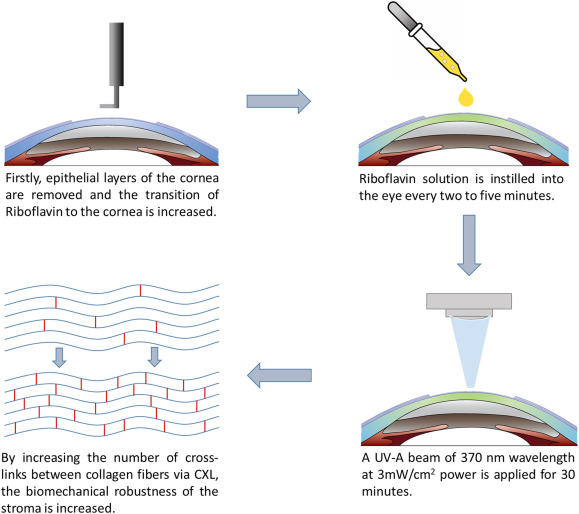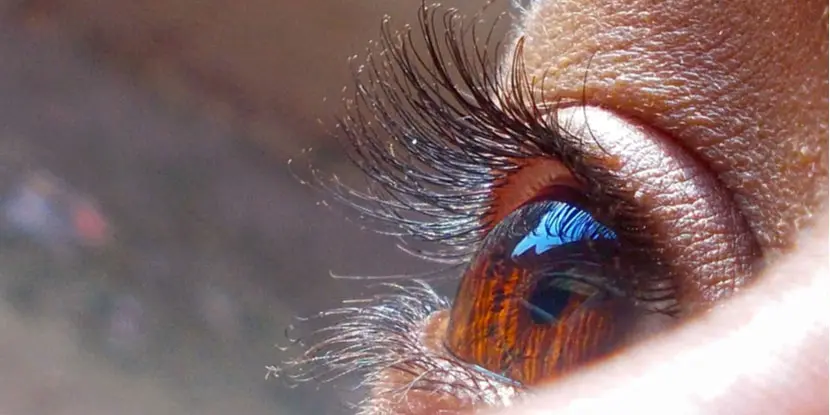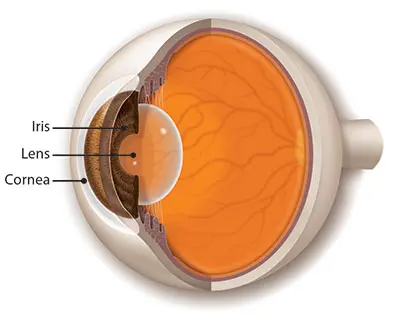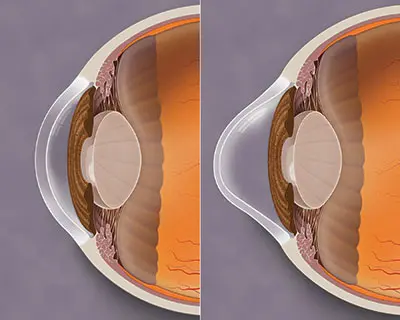Corneal Cross-Linking is a minimally invasive procedure designed to strengthen the cornea by creating new cross-links between collagen fibers. This helps to stabilize the cornea, slow or halt the progression of keratoconus, and prevent further vision deterioration.

Procedure
Preparation:
The patient is prepared for the procedure with the application of anesthetic eye drops to numb the eye.
Epithelium Removal:
There are two main types of CXL procedures:
Epi-off (standard CXL):
The outer layer of the cornea (epithelium) is removed to allow better penetration of the riboflavin solution.
Epi-on (transepithelial CXL):
The epithelium is left intact, which can result in less discomfort and faster recovery, though the penetration of riboflavin might be less efficient.
Riboflavin Application:
Riboflavin (vitamin B2) eye drops are applied to the cornea for about 30 minutes. This helps the cornea absorb the ultraviolet (UV) light used in the next step.
UV Light Exposure:
The cornea is then exposed to UV-A light for about 30 minutes. The combination of riboflavin and UV-A light induces the formation of new collagen cross-links.
Post-Procedure Care:
Antibiotic and anti-inflammatory eye drops are applied to prevent infection and reduce inflammation. A bandage contact lens may be placed on the eye to protect it during the initial healing period.

Benefits
Stabilization: CXL can effectively halt or slow the progression of keratoconus, reducing the need for corneal transplants in the future.
Safety: The procedure is generally safe with a low risk of complications.
Non-Invasive: Compared to other surgical options, CXL is minimally invasive and preserves the cornea.

Recovery
Healing Time: Patients typically experience discomfort for a few days post-procedure, especially with the epi-off method. Full recovery can take several weeks.
Follow-Up: Regular follow-up visits are necessary to monitor healing and the effectiveness of the treatment.
Types of Corneal Cross-Linking
Accelerated CXL: This method uses a higher intensity UV light for a shorter duration, aiming to achieve the same results in less time. It can be more comfortable and convenient for patients.
Customized CXL: Tailored to the individual patient’s corneal thickness and topography, this approach adjusts the parameters of the UV light and riboflavin application to optimize outcomes.
Risks and Considerations
Discomfort and Sensitivity: Temporary discomfort and light sensitivity are common, particularly in the first few days following the procedure.
Infection and Haze: Although rare, there is a risk of infection and corneal haze. Proper post-operative care and follow-up can mitigate these risks.
Effectiveness: While CXL is effective in halting the progression of keratoconus, it may not significantly improve existing vision distortion. Other treatments, like specialized contact lenses, may still be necessary for optimal vision correction.

Khanna Vision Institute
The Khanna Vision Institute, led by Dr. Rajesh Khanna, is renowned for its expertise in advanced eye care treatments, including corneal cross-linking. The institute offers personalized treatment plans for keratoconus patients, ensuring high-quality care and the best possible outcomes.
Expertise: Dr. Khanna and his team have extensive experience in treating keratoconus and performing corneal cross-linking.
Advanced Technology: The institute uses the latest technology and techniques to provide effective and safe treatments.
Comprehensive Care: Patients receive thorough evaluations and personalized care plans tailored to their specific needs.
Corneal Cross-Linking is a crucial surgical option for managing keratoconus, offering the potential to stabilize the cornea and preserve vision. The Khanna Vision Institute provides expert care with advanced technology, making it a reliable choice for patients seeking treatment for keratoconus. Regular follow-up and proper post-procedure care are essential for the best outcomes.